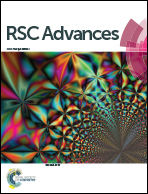A mitochondrial-targetable dual functional near-infrared fluorescent probe to monitor pH and H2O2 in living cells and mice†
Abstract
A lower pH level and high hydrogen peroxide (H2O2) concentration in mitochondria is closely associated with a variety of diseases including cancer and inflammation. Thus, determination of changes in the level of acidic pH and H2O2 is of great importance and could provide new insights into the key functions under both physiological and pathological conditions. Herein, we present a novel mitochondria-targetable probe NIR-pH-H2O2, as the first near infrared (NIR) fluorescent small molecule, to monitor changes of endogenous pH (pka = 6.17) and H2O2 with high sensitivity, good compatibility and low cytotoxicity. Futhermore, it was successfully employed to monitor pH and H2O2 in a mouse acute inflammation model. These results demonstrate that NIR-pH-H2O2 is a novel bifunctional mitochondrial-targeted NIR probe to sense acidic pH and H2O2 in vitro and in vivo, indicating its huge potential for the diagnosis of pH and H2O2-related diseases.



 Please wait while we load your content...
Please wait while we load your content...